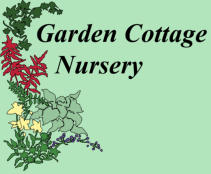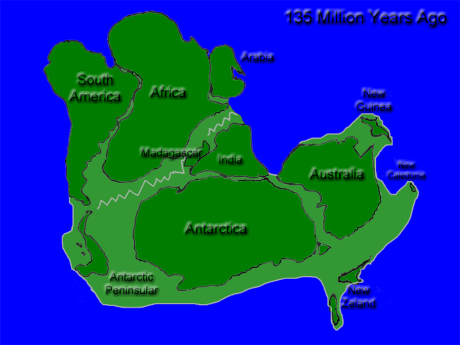
© Garden Cottage Nursery, 2022

Birth, Destruction And Legacy
Gondwana

Repeatedly over the Earth’s history all the land masses have congregated into a single Super Continent. The most recent of these
formed at the dawn of the age of the dinosaurs when the giant northern continent of Laurasia and giant southern continent of
Gondwana came together around 300 Million Years Ago (mya).
Gondwana split away again around 175mya.

As Gondwana, and Laurasia pulled apart the respective landmasses took samples of most plant and animal groups with them. In
their relative isolation life would evolve distinctly in the two continents.
Around 130mya are the oldest known fossils of flowering plants and they soon spread across both Laurasia and Gondwana. By the
time of the Cretaceous–Paleogene extinction event 66mya flowering plants had diversified into most of the orders (the
classification level above family) that exist today and started to displace conifers to dominate the worlds flora.


Not long from splitting off from Pangea
Gondwana itself started to break apart.
The chunks that made up Gondwana are
today South America, Africa and Arabia,
Madagascar, India, Antarctica, Australia,
New Guinea, New Caledonia and New
Zealand.

As Gondwana’s fragments drifted apart they took their shared distinctiveness of flora and fauna with them and continued to evolve
in distinction to each other after their separation. As some landmasses drifted near to fragments of Laurasia they saw an sudden
influx of new species that would alter their ecology, others like Australia and New Zealand, New Caledonia would remain in near
splendid isolation and keep their weird and wonderful creatures, like the
platypus, kiwi and kagu.

From a gardeners point of view the plant group that most readily represents shared Gondwanan heritage is the southern
beeches; Nothofagus.
Nothofagus was first described as a separate genus from the northern beeches (Fagus) by botanists in 1850. The 45 existing
species are deciduous and evergreen trees. They grow in Chile, Australia and Tasmania, New Zealand, New Caledonia and New
Guinea. Fossils of Nothofagus have also been found on Antarctica from plants that lived as recently as 3mya and in other parts of
Australia and South America that no longer have southern beech forests.
The existing species of Nothofagus fit into four distinct groups and it has recently been proposed that they be separated into four
genera:
“Nothofagus is recircumscribed to include five species from southern South America, Lophozonia and Trisyngyne are
reinstated, and the new genus Fuscospora is described. Fuscospora and Lophozonia, with six and seven species
respectively, occur in New Zealand, southern South America and Australia. Trisyngyne comprises 25 species from New
Caledonia, Papua New Guinea and Indonesia.” - HEENAN, PETER B.; SMISSEN, ROB D. (2013). "Revised circumscription of
Nothofagus and recognition of the segregate genera Fuscospora, Lophozonia, and Trisyngyne (Nothofagaceae)". Phytotaxa 146
(1): 131.
How can we know this? Well geologist are clever and canny. Geologists collect rock samples from all over the Earth’s surface and
like botanists have identified and classified them. Similar rocks have similar origins and likely arose together in the same place even
if they are separated by hundreds of miles today. When new crust is made it emerges as a liquid (lava) and contains small metallic
crystals that act like small compass needles before being trapped pointing to the pole as the new rock solidifies. The indicated force
lines in these rocks can then be compared with others and with what is known of the shape of the magnetic field at the time to
gauge where theses rocks were as they formed.

There are many other plant families, genera and even some species that grow wild today separated by thousands of miles from
each other in the Southern Hemisphere.
Gunneras have spread themselves far and wide:
While some plants grow or have close relative across different parts of Gondwana’s constituents others took a Gondwanan ‘seed’
as a jumping off point and have run with it:

Gondwana split in several chunks and is now scattered surrounded by oceans centred around Antarctica. Around 45-50mya the
South Tasman Rise was breached, isolating Antarctica from Australia and the uninterrupted circum-polar Antarctic Ocean was
formed. The now isolated Antarctica became drier and colder as warm, moist air could no longer reach it, loosing all it’s woody
vegetation by 3-2mya and it is now largely encased in kilometres thick ice.
The Southern Ocean has strong winds whipping around it constantly with little land mass to slow it or reduce the famously giant
waves of the ‘Roaring Forties’ and ‘Furious Fifties’.
Land that does descend into the Southern Maelstrom needs plants that are especially tolerant of salt winds and cool, moist
conditions. Sounds familiar doesn’t it West Coast Gardeners?!
So plants from the coasts of Southern Chile, Tierra del Fuego, Falklands, Tasmania and the South, Stewart and Chatham Islands of
New Zealand all experience similar conditions to ourselves with cool summers and mild winters, lots of rain and plenty of wind. As
such present us with a panoply of native plants suitable for our gardens.




© Garden Cottage Nursery, 2021

Birth, Destruction And Legacy
Gondwana

Repeatedly over the Earth’s history all the land masses have
congregated into a single Super Continent. The most recent of
these formed at the dawn of the age of the dinosaurs when the
giant northern continent of Laurasia and giant southern
continent of Gondwana came together around 300 Million
Years Ago (mya).
Gondwana split away again around 175mya.

As Gondwana, and Laurasia pulled apart the respective
landmasses took samples of most plant and animal groups with
them. In their relative isolation life would evolve distinctly in the
two continents.
Around 130mya are the oldest known fossils of flowering plants
and they soon spread across both Laurasia and Gondwana. By
the time of the Cretaceous–Paleogene extinction event 66mya
flowering plants had diversified into most of the orders (the
classification level above family) that exist today and started to
displace conifers to dominate the worlds flora.


Not long from splitting off from Pangea Gondwana itself started
to break apart. The chunks that made up Gondwana are today
South America, Africa and Arabia, Madagascar, India,
Antarctica, Australia, New Guinea, New Caledonia and New
Zealand.

As Gondwana’s fragments drifted apart they took their shared
distinctiveness of flora and fauna with them and continued to
evolve in distinction to each other after their separation. As
some landmasses drifted near to fragments of Laurasia they
saw an sudden influx of new species that would alter their
ecology, others like Australia and New Zealand, New
Caledonia would remain in near splendid isolation and keep
their weird and wonderful creatures, like the
platypus, kiwi and kagu.

From a gardeners point of view the plant group that most readily
represents shared Gondwanan heritage is the southern
beeches; Nothofagus.
Nothofagus was first described as a separate genus from the
northern beeches (Fagus) by botanists in 1850. The 45 existing
species are deciduous and evergreen trees. They grow in Chile,
Australia and Tasmania, New Zealand, New Caledonia and
New Guinea. Fossils of Nothofagus have also been found on
Antarctica from plants that lived as recently as 3mya and in
other parts of Australia and South America that no longer have
southern beech forests.
The existing species of Nothofagus fit into four distinct groups
and it has recently been proposed that they be separated into
four genera:
“Nothofagus is recircumscribed to include five species from
southern South America, Lophozonia and Trisyngyne are
reinstated, and the new genus Fuscospora is described.
Fuscospora and Lophozonia, with six and seven species
respectively, occur in New Zealand, southern South America and
Australia. Trisyngyne comprises 25 species from New
Caledonia, Papua New Guinea and Indonesia.” - HEENAN,
PETER B.; SMISSEN, ROB D. (2013). "Revised circumscription
of Nothofagus and recognition of the segregate genera
Fuscospora, Lophozonia, and Trisyngyne (Nothofagaceae)".
Phytotaxa 146 (1): 131.
How can we know this? Well geologist are clever and canny.
Geologists collect rock samples from all over the Earth’s
surface and like botanists have identified and classified them.
Similar rocks have similar origins and likely arose together in
the same place even if they are separated by hundreds of
miles today. When new crust is made it emerges as a liquid
(lava) and contains small metallic crystals that act like small
compass needles before being trapped pointing to the pole as
the new rock solidifies. The indicated force lines in these rocks
can then be compared with others and with what is known of
the shape of the magnetic field at the time to gauge where
theses rocks were as they formed.

There are many other plant families, genera and even some
species that grow wild today separated by thousands of miles
from each other in the Southern Hemisphere.
Gunneras have spread themselves far and wide:
While some plants grow or have close relative across different
parts of Gondwana’s constituents others took a Gondwanan
‘seed’ as a jumping off point and have run with it:

Gondwana split in several chunks and is now scattered
surrounded by oceans centred around Antarctica. Around 45-
50mya the South Tasman Rise was breached, isolating
Antarctica from Australia and the uninterrupted circum-polar
Antarctic Ocean was formed. The now isolated Antarctica
became drier and colder as warm, moist air could no longer
reach it, loosing all it’s woody vegetation by 3-2mya and it is
now largely encased in kilometres thick ice.
The Southern Ocean has strong winds whipping around it
constantly with little land mass to slow it or reduce the famously
giant waves of the ‘Roaring Forties’ and ‘Furious Fifties’.
Land that does descend into the Southern Maelstrom needs
plants that are especially tolerant of salt winds and cool, moist
conditions. Sounds familiar doesn’t it West Coast Gardeners?!
So plants from the coasts of Southern Chile, Tierra del Fuego,
Falklands, Tasmania and the South, Stewart and Chatham
Islands of New Zealand all experience similar conditions to
ourselves with cool summers and mild winters, lots of rain and
plenty of wind. As such present us with a panoply of native
plants suitable for our gardens.



















